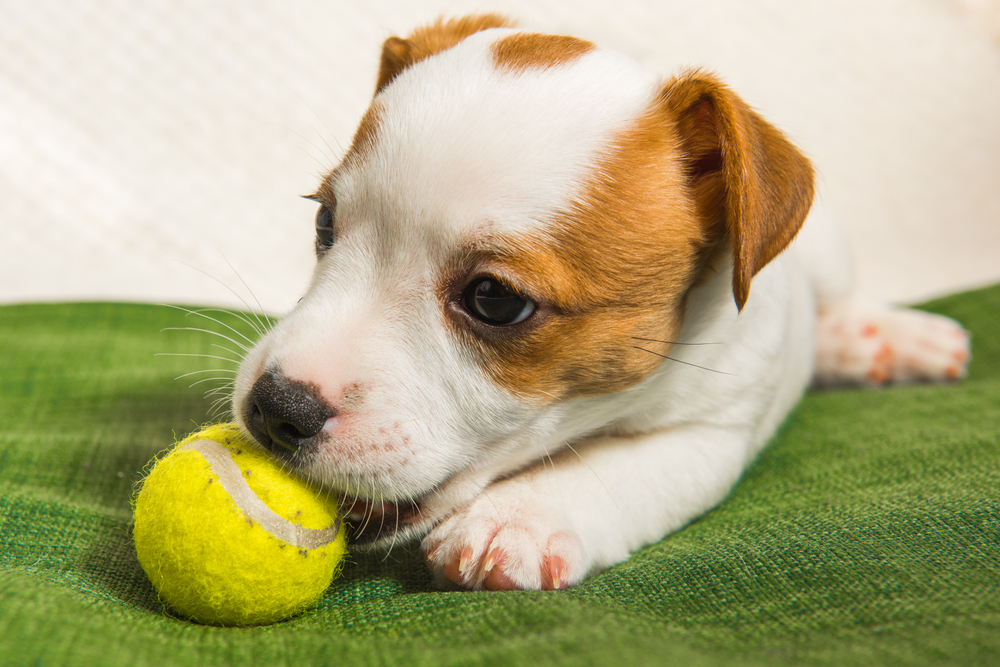A teething puppy can be a handful. Parents know that teething babies can be irritable due to sore gums, and they’re likely to chew on anything within reach. Puppies are the same, which could result in ruined shoes and furniture when pet parents aren’t prepared for this season of life with their dog.
Why do puppies teethe? For the same reason human babies do: Their baby teeth are coming in, or their adult teeth are replacing those baby teeth. Puppies start teething pretty early — around 3 weeks of age. Depending on the breed, puppies stop teething between 4 and 7 months.
A puppy teething can present a challenging time for pet parents, who may need to be more observant and set specific boundaries. But with tools like the Halo Collar, this can also be a rewarding, playful stage that helps you grow closer to your dog.
Puppy Teething Symptoms
During the first year with your puppy, keep an eye out for telltale signs of your dog’s teething. This can help you prepare to care for your furry friend as you set boundaries to keep your personal belongings away from new puppy teeth. Some puppy teething symptoms include:
- Excessive chewing. If your pup is gnawing on everything in sight, it might be how it’s dealing with teething pain.
- More drooling than usual. As with a human baby, teething can cause extra saliva creation, leading to drool.
- Swollen or red gums. This can be a sign that teeth are trying to break through the surface, causing irritated gums.
- Whining. If your pup is whining or whimpering without any other obvious cause, it could be a reaction to teething pain.
- Difficulty eating. Puppies with irritated gums might turn their nose up at food, especially hard kibble.
- Slight fever. It’s natural for puppies to run a low-grade temperature when their bodies are dealing with teething.
Soothing Your Puppy’s Sore Gums
Pet parents can do several things to help their teething puppy find pain relief.
Cold Comfort
Provide cold comfort to help reduce swelling and irritation in the form of frozen chew toys. You can freeze Kongs or fill them or other rubber toys with frozen treats. You could also provide chilled carrots or apples or let your pup gnaw on a washcloth you wet and then freeze.
Safe and Effective Teething Toys
Most pet stores carry a variety of chew toys to promote healthy chewing habits. Try a variety of textures, including soft plushes, rope and hard rubber, to figure out what works best for your pup. You might also want to invest in teething rings designed for teething puppies.
Of course, puppies don’t always stick to the toys you provide when chewing to reduce teething irritation. Anything you provide your pup might turn into a chew toy, which is why Halo Collar features a chew-proof design. While it’s not intended as a chew toy, it is durable enough to withstand any gnawing that occurs during this phase of life with your dog.

Protecting Your Home (and Your Sanity!)
To best protect your home and ensure you and your pup have a good relationship, first make sure you know when puppies lose teeth. Keep an eye out for incoming baby teeth so you can puppy-proof your home and provide your furry friend with tools to manage teething symptoms.
Puppy-Proofing
To keep your puppy from biting dangerous items, secure electrical cords, loose wires and anything else that might harm your pet. Puppies chew soft things sometimes, so your furniture, shoes and clothing might be at risk. Put things away when you can, especially valuable items you don’t want to be harmed by puppy chewing. Start setting boundaries with your puppy to designate chew zones filled with appropriate toys that are safe to gnaw on.
Using the Halo Collar for Prevention
You can use a wireless dog fence to set up “Keep Out” zones to ensure your puppy doesn’t have access to furniture, rooms or areas where chewing might cause damage to valuable objects. Remember that puppy chewing is a natural instinct, so it’s important to provide your dog with options for engaging safely and appropriately in this activity.
You can control Halo Collar features from your smartphone, making it easy to manage boundaries. For example, taking the step to keep a chewing puppy out of the bedroom could save your expensive duvet or a favorite pair of shoes from those new teeth.
Puppy Training and Redirection
Many pet parents are inconsistent during the puppy years. It’s important to be consistent in training your teething puppy by:
- Providing positive reinforcement. Reward your puppy for good chewing behavior.
- Using the “Ouch” technique. Signal that biting is unpleasant by yelping like a dog when your pup nips you.
- Redirecting to appropriate toys. Take away shoes or other items and say “Leave it!” while providing your pup with a better option.
- Using Halo Collar feedback. Leverage the vibration or sound feedback to reinforce commands such as “Leave it.”
Dental Care for Teething Puppies
Puppy owners should also engage in dental care for dog’s teeth, starting with the teething stage. Begin with puppy-specific toothpaste to brush your dog’s teeth. You can also introduce dental chews and treats to help clean teeth and talk to your vet about a dental evaluation to ensure your dog’s teeth look good as they come in.
Puppy Teething Triumph: You’ve Got This!
A teething puppy can be a handful, but this is a short-lived phase. With a little care and planning, the playful, fun side of your pup can more than make up for teething challenges. Working during this time to set loving boundaries and provide gentle correction can help you bond with your dog.
Learn more about Halo Collar 4 to help with puppy training and safety, and share your puppy teething experiences in the comments.










